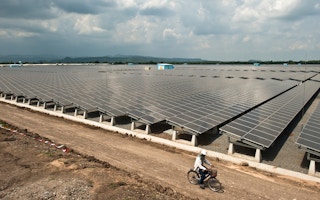As governments, companies, and individuals the world over are increasingly seeking to address their contributions to global warming, the use of voluntary carbon markets is starting to accelerate after several years of slow growth.
That’s the finding of a new report released yesterday by Ecosystem Marketplace, an initiative of the NGO Forest Trends. According to the report, the supply of carbon credits on voluntary markets hit an all-time-high in 2017 of 62.7 million metric tons of carbon dioxide equivalent (MtCO2e), while 42.8-MtCO2e-worth of offsets were purchased and retired — also a record.
Offsets are produced through a number of activities, such as installing new renewable energy production capacity, managing forests and other ecosystems to improve carbon sequestration, and implementing low-emissions agricultural practices. Developers of projects that lead to reduced emissions in 83 countries currently sell offsets on voluntary markets.
“The vast majority of projects on the voluntary market follow rules and procedures set out by a voluntary carbon standard,” the report explains. “If a project meets these criteria, the standard will issue carbon offsets equivalent to the emissions reductions.”
More than 2,000 projects have issued offsets based on voluntary carbon standards since 2005. Buyers of those offsets can then claim the emissions reductions for themselves by “retiring” the offsets they’ve purchased, meaning they’ve removed them from circulation.
The number of offsets that have been generated is generally considered to be the best way to estimate the environmental impact of voluntary carbon markets. According to the report: “Since 2005, projects have helped to reduce, sequester, or avoid over 437.1 MtCO2e. That is more than all of Australia’s energy-related emissions in 2016. Last year alone, projects issued 62.7 MtCO2e: a record high for the market. That is the equivalent of not consuming almost 150 million barrels of oil.”
The report notes that there are a number of reasons for the uptick in voluntary carbon markets, but chiefly credits the signing of the Paris Climate Agreement in December 2015 for raising awareness around the need for climate action and in turn leading to the higher volume of offsets issued and retired in 2017. (Ironically, by announcing its intent to pull out of the Paris Agreement last year, the Trump Administration might have motivated more people and businesses to take action on their own, the report adds.)
“
Since 2005, projects have helped to reduce, sequester, or avoid over 437.1 MtCO2e. That is more than all of Australia’s energy-related emissions in 2016.
The authors of the report suggest that there are two primary reasons why the increased volume of trading on voluntary carbon markets last year could be just the beginning of a longer growth trend. The first is that several countries, in seeking to meet their commitments under the Paris Climate Agreement, are starting to use voluntary carbon offsets as a means of accelerating the pace of decarbonization within their economies.
The second reason is that airlines could begin using voluntary offsets, as well, in order to meet the global cap on airline emissions set by the Carbon Offsetting and Reduction Scheme for International Aviation (CORSIA). The first market-based measure ever adopted to regulate an entire global industry, CORSIA was adopted by the International Civil Aviation Organization (ICAO) in 2016 to monitor the carbon emissions produced by the international aviation sector and achieve carbon neutral growth by 2020. Any airline that operates international flights out of one of the 192 ICAO member states will be required to monitor, report, and verify their emissions starting January 1, 2019.
“We’ve been tracking voluntary carbon markets for more than a decade, and it’s been about that long since we’ve seen this much potential for growth,” the report’s lead author, Kelley Hamrick, said in a statement.
The Paris Agreement and CORSIA create what are known as compliance markets, which is when government regulators require greenhouse gas emitters to either reduce or offset their emissions, as opposed to those entities doing so voluntarily. (Another prominent example: A key component of the law California passed in 2006 that required the U.S. state to reduce its emissions to 1990 levels by 2020 was a cap-and-trade program that is the only economy-wide compliance market in the United States and one of the largest in the world.)
Hamrick warns that much of the future growth of the world’s voluntary carbon markets depends on the degree to which these compliance markets recognize offsets generated under voluntary systems. If regulators allow offsets issued under voluntary standards to be bought and sold in order to satisfy compliance market obligations under the Paris Agreement and CORSIA, for instance, that would certainly boost voluntary markets.
“Voluntary and compliance markets are usually treated as two different things, but a decision to allow voluntary offsets into a compliance market could vacuum up existing supply and create a powerful incentive for new projects,” Hamrick said.
“In the meantime, voluntary market participants aren’t waiting idly for a government decision; they are exploring ways to integrate new technologies like blockchain into tracking and registration schemes, and starting to bring carbon-accounting rigor to the many additional benefits — like biodiversity and gender equality — brought about by carbon projects.”
This story was published with permission from Mongabay.com. Read the full story.










